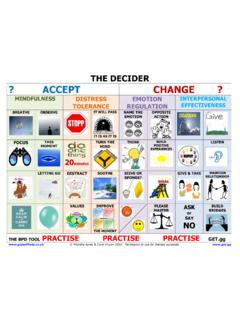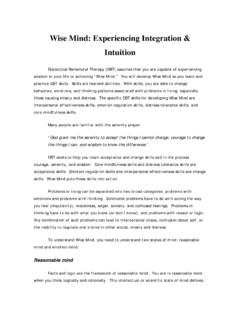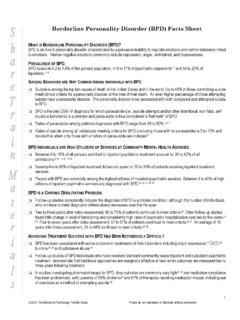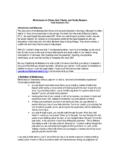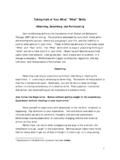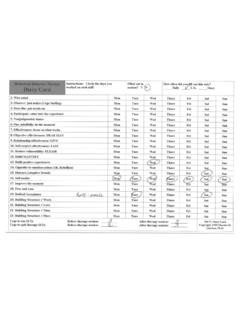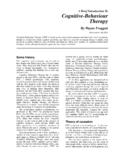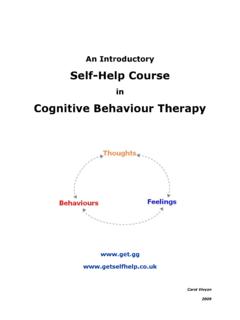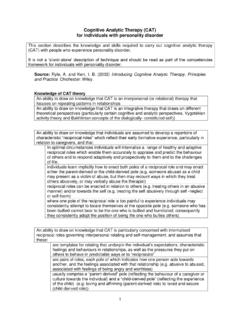Transcription of Dialectical Behavior Therapy in a Nutshell
1 Dialectical Behavior Therapy in a Nutshell Linda Dimeff The Behavioral Technology Transfer Group Seattle, Washington Marsha M. Linehan Department of Psychology University of Washington Seattle, Washington Dimeff, L., & Linehan, (2001). Dialectical Behavior Therapy in a Nutshell . The California Psychologist, 34, 10-13. INTRODUCTION Dialectical Behavior Therapy (DBT) is a comprehensive cognitive-behavioral treatment for complex, difficult-to-treat mental disorders (Linehan, 1993a,b). Originally developed for chronically suicidal individuals, DBT has evolved into a treatment for multi-disordered individuals with borderline personality disorder (BPD).
2 DBT has since been adapted for other seemingly intractable behavioral disorders involving emotion dysregulation, including substance dependence in individuals with BPD (Linehan, Schmidt, Dimeff, Craft, Kanter, & Comtois, 1999; Dimeff, Rizvi, Brown, & Linehan, 2000), binge eating (Telch, Agras, & Linehan, in press), depressed, suicidal adolescents(Miller, 1999; Rathus & Miller, 2000), depressed elderly (Lynch, 2000), and to a variety of settings, including inpatient and partial hospitalization, forensic settings (Swenson, Sanderson, Dulit, & Linehan, in press; McCann & Ball, 1996; McCann, Ball, & Ivanoff, under review).
3 DBT is based on a combined capability deficit and motivational model of BPD which states that (1) people with BPD lack important interpersonal, self-regulation (including emotional regulation) and distress tolerance skills, and (2) personal and environmental factors often both block and/or inhibit the use of behavioral skills that clients do have, and reinforce dysfunctional behaviors. DBT combines the basic strategies of Behavior Therapy with eastern mindfulness practices, residing within an overarching Dialectical worldview that emphasizes the synthesis of opposites.
4 The term Dialectical is also meant to convey both the multiple tensions that co-occur in Therapy with suicidal clients with BPD as well as the emphasis in DBT of enhancing Dialectical thinking patterns to replace rigid, dichotomous thinking. The fundamental dialectic in DBT is between validation and acceptance of the client as they are within the context of simultaneously helping them change. Acceptance procedures in DBT include mindfulness ( , attention to the present moment, assuming a non-judgmental stance, focusing on effectiveness) and a variety of validation and acceptance-based stylistic strategies.
5 Change strategies in DBT include behavioral analysis of maladaptive behaviors and problem-solving techniques, including skills training, contingency management ( , reinforcers, punishment), cognitive modification, and exposure-based strategies. As a comprehensive treatment, DBT serves the following five functions: 1) enhances behavioral capabilities, 2) improves motivation to change (by modifying inhibitions and reinforcement contingencies), 3) assures that new capabilities generalize to the natural environment, 4) structures the treatment environment in the ways essential to support client and therapist capabilities, and 5) enhances therapist capabilities and motivation to treat clients effectively.
6 In standard DBT, these functions are divided among modes of service delivery, including individual psychotherapy, group skills training, phone consultation, and therapist consultation team. ORIGINS OF DBT DBT grew out of a series of failed attempts to apply the standard cognitive and Behavior Therapy protocols of the late 1970 s to chronically suicidal clients. These difficulties included: To overcome these difficulties, several modifications were made that formed the basis of DBT. First, strategies that reflect radical acceptance and validation of clients current capabilities and behavioral functioning were added to the treatment.
7 The synthesis of acceptance and change within the treatment as a whole and within each treatment interaction led to adding the term Dialectical to the name of the treatment. This Dialectical emphasis brings together in DBT the technologies of change based on both principles of learning and crises theory and the technologies of acceptance (so to speak) drawn from principles of eastern Zen and western contemplative practices. Second, the Therapy as a whole was split into several different components, each focusing on a specific aspect of treatment.
8 The components in standard outpatient DBT are highly structured individual or group skills training (to enhance capability), individual psychotherapy (addressing motivation and skills strengthening), and telephone 1. focusing on change procedures was frequently experiencedas invalidating by the client and often precipitated withdrawal from Therapy , attacks on the therapist, or vacillations between these two poles; 2. teaching and strengthening new skills was extraordinarily difficult to do within the context of an individual Therapy session while concurrently targeting and treating the client s motivation to die and suicidal behaviors that had occurred during the previous week; 3.
9 Individuals with BPD often unwittingly reinforced the therapist for iatrogenic treatment ( , a client stops attacking the therapist when the therapist changes the topic from one the client is afraid to discuss to a pleasant or neutral topic) and punished them for effective treatment strategies ( , a client attempts suicide when the therapist refuses to recommend hospitalization stays that reinforce suicide threats). Page 2 of 2 Dimeff, L., & Linehan, (2001). Dialectical Behavior Therapy in a Nutshell . The California Psychologist, 34, 10-13. contact with the individual therapist (addressing application of coping skills).
10 Third, a consultation/team meeting focused specifically on keeping therapists motivated and providing effective treatment was also added. BEHAVIORAL TARGETS AND STAGES OF TREATMENT IN DBT DBT is designed to treat clients at all levels of severity and complexity of disorders and is conceptualized as occurring in stages. In Stage 1, the primary focus is on stabilizing the client and achieving behavioral control. Behavioral targets in this initial stage of treatment include: decreasing life-threatening, suicidal behaviors ( , parasuicide acts, including suicide attempts, high risk suicidal ideation, plans and threats), decreasing Therapy -interfering behaviors ( , missing or coming late to session, phoning at unreasonable hours, not returning phone calls), decreasing quality-of-life interfering behaviors ( , reducing behavioral patterns serious enough to substantially interfere with any chance of a reasonable quality of life ( , depression, substance dependence, homelessness, chronically unemployed))

